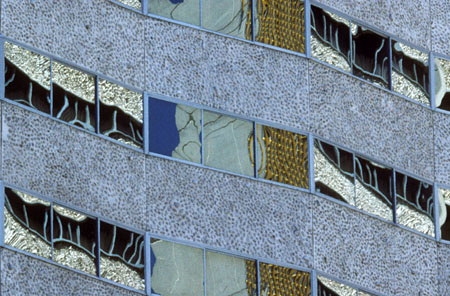Abstract and surreal architectural reflections often make wonderfully colourful and interesting images, although a trained eye is required to spot them. The glass surfaces of modern buildings are perhaps the most common sources of good subjects, but it is necessary in most cases to zoom in fairly close with a telephoto lens and develop a good sense of how to arrange the subjects in the frame. It is impossible to write rules for this sort of composition - just keep taking pictures and observe which ones work the best. However, it is probably true to say that straight vertical and horizontal lines should not run directly up and down or across the frame.
 Looking upwards at a steep angle with a telephoto lens produces all sorts of interesting perspective effects. vertical and horizontal lines become converging diagonals and in most cases this is entirely beneficial from the point of view of composition. Framing tightly an interesting area of reflection produces an abstract image because the wavy areas of colour are isolated from the subject as a whole. The viewer may consequently not be able to identify the subect of the image, but that does not matter in the least. Provided the arrangement of colours and shapes is pleasing to the eye, an image of this type can be very acceptable.
Looking upwards at a steep angle with a telephoto lens produces all sorts of interesting perspective effects. vertical and horizontal lines become converging diagonals and in most cases this is entirely beneficial from the point of view of composition. Framing tightly an interesting area of reflection produces an abstract image because the wavy areas of colour are isolated from the subject as a whole. The viewer may consequently not be able to identify the subect of the image, but that does not matter in the least. Provided the arrangement of colours and shapes is pleasing to the eye, an image of this type can be very acceptable.
A key element in the creation of abstract reflection images is the existence of variations in the reflecting plane. A window that bows slightly outward or inwards, or a highly-polished metal surface that is not perfectly flat, is likely to be a more interesting source of relections because the reflected subject will be distorted to some extent. The effect is most clearly seen in the surface of rippled water since the reflection can be seen to change constantly. However, the same principle can be used in the case of static non-planar surfaces. Small changes of viewpoint may produce quite different images, so move around to optimize each image.






